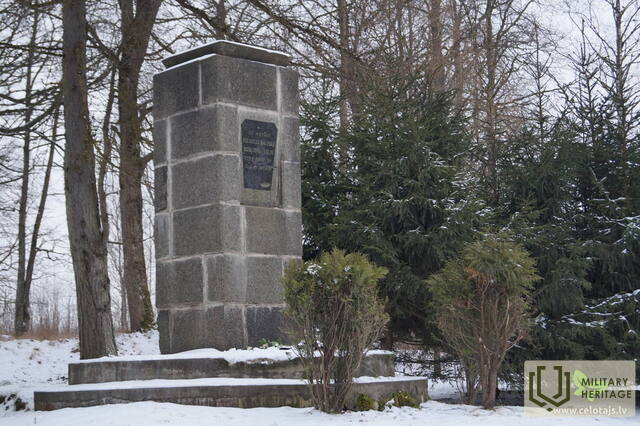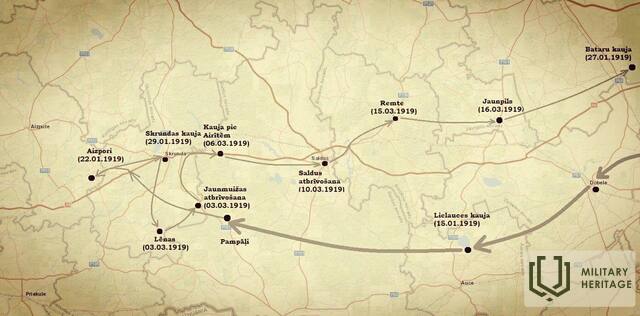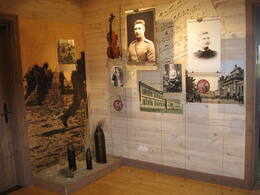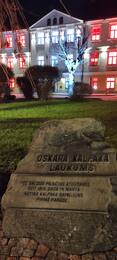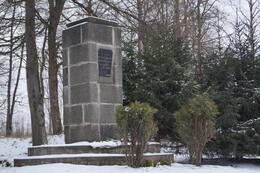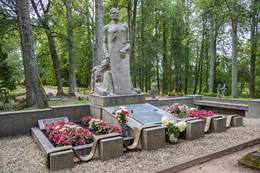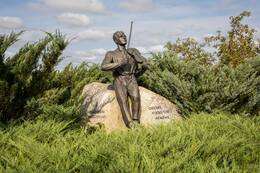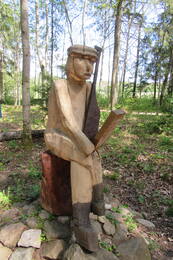Oskaro Kalpako bataliono mūšis netoli Lielaucės
Sausio 15-osios naktį Kalpako batalionas kovojo pirmąjį mūšį Lielaucėje, atremdamas raudonųjų puolimą. Tai buvo pirmasis reikšmingas Kalpako bataliono mūšis, o pergalė suteikė kariams ypač stiprų moralinį postūmį.
Kalpako batalionas Lielaucėje tolimaisiais 1919 metais išbuvo tik tris dienas, tačiau šis mūšis išliko labai reikšmingu momentu Latvijos istorijoje. „Karinės pajėgos buvo nedidelės, dalis Latvijos armijos buvo Vokietijos armijos sudėtyje, kai Raudonoji armija įžengė į Latviją su didžiuliu pranašumu. Dėl kruopštaus žvalgų darbo šis mūšis buvo trumpas, bet kruvinas, prasidėjęs po vidurnakčio, leisdamas abiem pusėms padaryti klaidų – „raudonieji“, pamatę Kalpako bataliono paliktas šviesas pilies antrame aukšte, sugebėjo nustatyti atakos taikinį, tačiau du, – toliau Duobelės link išsidėstę kareiviai, pastebėjo puolėjus, nors siautė gili pūga ir raketinis pabūklas taip pat neveikė, pabėgę ir teisingai įspėję, mūšis neturėjo netikėto fono. Pirmasis krito leitenantas Pēteris Dambītis, nes buvo palikęs savo kareivio batus šalia savęs poste, todėl nespėjo jų apsiauti... Kalpako batalionas nebuvo nugalėtas dėl „raudonųjų“ nekompetencijos, nes pranašumas buvo tris kartus didesnis – puolę kareiviai nepastebėjo, kad kulkosvaidžio vamzdyje užšalo vanduo, o tai taip pat padėjo laimėti šį mūšį (..). Štai kaip...“ Latvijos nacionalinės gvardijos veteranų asociacijos vadovas majoras Ilgvaras Baumanis atminimo ceremonijoje Lielaucėje (~2015 m.) kalbėjo apie pirmąjį Kalpako mūšį.
Aucės apskrities turizmo informacijos centras, 2016-09-30
Susijusios temos
Susijusios vietos
Oskaro Kalpako muziejus ir memorialinė vieta „Airītes“
Oskaro Kalpako muziejus ir memorialinė vieta „Airītes“ yra tarp Saldaus ir Skrundos, netoli greitkelio A9. Parodoje pateikiama išsami informacija apie pulkininką Oskarą Kalpaką ir jo batalioną, taip pat pristatoma Latvijos nacionalinės armijos ir memorialinės vietos „Airītes“ istorija. Parodoje pulkininką Oskarą Kalpaką pristatoma kaip asmenybę, kaip karį ir kaip kovotoją už Latvijos nepriklausomybę. Parodoje taip pat yra garso įrašų latvių, anglų ir vokiečių kalbomis. Juose pabrėžiama 1918/1919 m. istorinių įvykių svarba saugant Latvijos valstybingumą. Muziejaus pastatas yra restauruotas.
Įėjimas nemokamas; ekskursija su gidu – mokama. Komplekse yra poilsio zona, parkas, kliūčių ruožas, galima lankyti įvairius užsiėmimus, yra seminarų salė iki 30 žmonių.
Memorial stone in Oskaras Kalpaka Square in Saldus
O. Kalpakos aikštė yra pačiame Saldaus centre, Lielā ir Striķu gatvių sankryžoje.
Buvusi turgaus aikštė šiandien yra mėgstama Saldaus gyventojų ir svečių poilsio vieta, kurioje rengiami koncertai, minėjimai ir šventės. 1919 m. kovo 10 d. Saldaus tapo pirmuoju Latvijos miestu, kurį išlaisvino pulkininko Oskaro Kalpako batalionas.
1919 m. kovo 14 d. aikštėje įvyko pirmasis Latvijos atskirojo bataliono paradas, o 1992 m., pulkininko Kalpako garbei, aikštė buvo pavadinta jo vardu.
Oskaro Kalpako bataliono pirmajam mūšiui skirtas paminklas Lielaucėje
Paminklas pirmajam Oskaro Kalpako bataliono mūšiui atminti stovi prie Lielaucės liuteronų bažnyčios griuvėsių. Jis pastatytas toje vietoje, kur naktį iš 1919 m. sausio 15 d. į 16 d. įvyko pirmasis svarbus Kalpako bataliono mūšis. Tą naktį dvi Kalpako bataliono kuopos atrėmė viso bolševikų bataliono ir kavalerijos eskadrono puolimą. Kadangi Landesveras pralaimėjo mūšį Aucėje, buvo nuspręsta atsitraukti ir laikyti frontą prie natūralios kliūties – Ventos upės.
Paminklas buvo atidengtas 1934 m. rugpjūčio 19 d., dalyvaujant buvusiam Kalpako bataliono kariui, žemės ūkio ministrui J. Kauliniui. Paminklo autorius – architektas P. Dreimanis, o pastatė J. Sierinis. Paminklas pastatytas iš pilko granito blokų, o jo priekyje pritvirtinta juodo granito lenta su užrašu: „Čia 1919 m. sausį iš 15 d. į 16 d. įvyko pulkininko Kalpako bataliono mūšis.“ Per šį mūšį žuvo keturi kariai.
XX a. 6. deš. pradžioje paminklas buvo sunaikintas, o lenta sudaužyta. 1991 m. jis buvo atstatytas, panaudojant originalią lentą, kuri buvo perskelta į dvi dalis. Atstatytame paminkle lenta yra nebe iš bažnyčios pusės, o atsukta į Lielaucės centrą.
Atminimo lentos Lubanos gyventojams, žuvusiems Pirmajame pasauliniame kare ir Nepriklausomybės kare, Lubanos liuteronų bažnyčioje
Įsikūręs Lubanoje, Baznīcas g. 1, liuteronų bažnyčioje.
Lubanos bažnyčioje galima pamatyti tarpukariu įrengtą balto marmuro atminimo lentą pulkininkui Oskarui Kalpakui. 1924 m. birželio 22 d. bažnyčioje buvo atidengta atminimo lenta žuvusiems Lubanos vidurinės mokyklos mokiniams. 1926 m. buvo atidengta Lubanos parapijos įrengta atminimo lenta žuvusiems parapijos gyventojams, taip pat atminimo lenta ministrui pirmininkui Hugo Celminiui, gimusiam Lubanos parapijos „Naglinoje“.
Medžiagos apie Oskaro Kalpako ir Hugo Celminio kasdienį gyvenimą galima pamatyti Lubanos kultūros ir istorijos paveldo bei turizmo informacijos centro parodoje.
Pulkininko Oskaro Kalpako amžinojo poilsio vieta
Įsikūręs Visagalos kapinėse, Madonos apskrityje
Eksponuojamas Oskaro Kalpako paminklas, atidengtas 1927 m. liepos 10 d., Kārlio Zālės ir Arnoldio Dzirkalio – trijų figūrų kompozicija, kurios centre pavaizduotas senovės latvių karys su skydu ir kardu rankose, o abiejose jo pusėse stovi du kariai. Skulptūrinės grupės papėdėje ant granito pagrindo įstrižai pritvirtinta bronzinė lentelė, kurioje išgraviruotas tekstas, kuriame yra ir Edvardo Virzos eilėraštis, skirtas Kalpakui.
Oskaras Kalpakas žuvo 1919 m. kovo 6 d. netoli „Airītē“, Skrundos–Saldus kelio pakraštyje, o jo palaikai rugsėjo 18 d. iš Liepojos šiaurinių kapinių buvo perkelti į šeimos kapines Visagaloje.
Paminklą atidengė pulkininko O. Kalpako paminklo komiteto pirmininkas generolas J. Balodis, dalyvaujant tuometiniam Respublikos prezidentui G. Zemgalui, ministrui pirmininkui M. Skujeniekui, Saeimos pirmininkui P. Kalniniui, karo ministrui R. Bangerskiui ir K. Ulmaniui. Paminklo kertinis akmuo buvo padėtas 1925 m. birželio 19 d. Paminklo akmuo buvo paimtas iš pulkininko gimtųjų namų Sienos pelkėje, ant šio akmens O. Kalpakas vaikystėje mėgo groti smuiku.
Pulkininko Oskaro Kalpako „Liepsalos“ gimtinė ir amžinojo poilsio vieta Visagalo kapinėse
Pulkininko Oskaro Kalpako šeimos memorialas Liepsaluose yra Maduonos ir Lubano ežero teritorijoje. Liepsalas yra Kalpako vaikystės namai. Memorialinė vieta čia buvo įkurta 1997 m., remiantis pulkininko dukterėčios Ārijos Kalpako-Grundmanės (1922–2006) idėjomis ir panaudojant jos išteklius. Vietovėje eksponuojami įvairūs aplinkos objektai ir akmens skulptūros, turinčios simbolinę reikšmę, perteikiančios Latvijos etines ir patriotines vertybes. Didžiausiame pastate įrengta ekspozicija, skirta Latvijos nepriklausomybės karo istorijai ir 22 Latvijos laisvės metams (1918–1940). Visagalo kapinėse esantis Oskaro Kalpako paminklas, kurį sukūrė Kārlis Zāle ir Arnolds Dzirkals, buvo atidengtas 1927 m. Paminklą sudaro trijų figūrų kompozicija, kurios centre – senovės latvių karys, laikantis skydą ir kardą, o iš abiejų pusių – po krintantį karį. Skulptūrinės grupės papėdėje ant granito pagrindo įstrižai pritvirtinta bronzinė lentelė su išgraviruotu tekstu, įskaitant Edvardo Virzos Kalpaksui skirtą eilėraštį. Oskaras Kalpaksas mirė 1919 m. kovo 6 d. netoli Airytės, prie kelio iš Skrundos į Saldų.
Oskaro Kalpako muziejaus „Gamtos ir stiprybės takas“
Gamtos takas buvo sukurtas greta muziejaus esančioje teritorijoje ir yra paremtas 1936 m. O. Kalpako muziejaus ir jo aplinkos projekto idėja. Individualūs muziejaus lankytojai gamtos taku gali naudotis nemokamai.
Gamtos take eksponuojamos Kuldygos technologijų ir turizmo technikumo organizuoto medžio apdirbėjų plenero, kurio jungianti tema – „Už meilę laisvei“, metu sukurtos medinės skulptūros. Taip pat eksponuojami didelio formato paveikslai iš plenero „Saugok savo Tėvynę!“, kuriuos nutapė aplinkinių regionų moksleivių komandos.
Gamtos take taip pat įrengtas mini oro takelis jauniausiems muziejaus lankytojams.
Pirmasis Lielaucės pilies ir Oskaro Kalpako bataliono mūšis
Lielaucės dvaras su parku – objektas, Latvijos istorijoje siejamas su Pirmuoju Kalpako mūšiu, įvykusiu Nepriklausomybės karo metu 1919 m. sausį, ir jo pergale. Dabartinis dvaro pastatų ansamblis iš esmės susiformavo XIX a. pradžioje. Dvaro rūmai iš pradžių buvo statomi imperijos stiliumi kaip dviejų aukštų pastatas su čerpių stogu. Komplekso ūkiniai pastatai yra atokiau nuo dvaro parko. Išliko valdytojo namas, kuris vėliau buvo perstatytas į kultūros centrą, arklidės, tarnų namas ir ledo rūsys tvenkinio pusėje. Išliko tik 1801 m. statyto klėtis pamatai, tačiau kūginės krosnies tūriai, nors ir atstatyti, yra gerai išsaugoti. Taip pat galima apžiūrėti dvaro vežiminę arba kareivių tvartą.
Įkūrus Latvijos valstybę, Lielaucės dvaro pastatas su gretimu ežeru, parku, pastatais ir tam tikru miško plotu pirmiausia buvo perduotas vaikų namams įkurti, tačiau jie nebuvo įkurti. 1926 m. lapkritį Latvijos universiteto Žemės ūkio fakulteto Miškų ūkio katedra perėmė Centrinio žemės komiteto suteiktą Lielaucės pilį su parku ir 59 hektarų žemės sklypu, skirtu mokomiesiems užsiėmimams organizuoti. Po Antrojo pasaulinio karo, iki 2009 m., čia veikė Lielaucės pradinė mokykla, o tuo pačiu metu – ir LLU aptarnavimo viešbutis. Šiuo metu dvaras ir parkas priklauso SIA „Mudia“. Kol nebus pagerinta dvaro techninė būklė, jis lankytojams neprieinamas.
1919 m. sausio 15 d. naktį Kalpako batalionas kovėsi pirmajame mūšyje Lielaucėje, atremdamas raudonųjų puolimą. Tai buvo pirmasis reikšmingas Kalpako bataliono mūšis, kai pergalė suteikė kariams ypač stiprų moralinį postūmį.
Atsitraukimo metu, sausio 12 d., Latvijos atskirasis batalionas pasiekė Lielaucės dvaro pilį ir ten įsikūrė pailsėti, įrengdamas sargybos postus aplinkiniuose keliuose. Ankstyvą sausio 16 d. rytą sargybiniai pastebėjo artėjantį priešą Duobelės plentu ir spėjo įspėti pilyje buvusius asmenis. Pirmieji į mūšį įsitraukė Karininkų rezervo kuopa, užėmusi pozicijas prie dvaro pastato. Cėsių kuopa, padalinta į dvi dalis, bandė apsupti priešą. Iš pradžių bolševikai atsitraukė, bet vėliau pradėjo kontrataką, kurią Cėsių kuopai pavyko atremti. Priešas buvo priverstas trauktis. Iškovota pirmoji pergalė prieš bolševikus. Nors kalpakiečiai patyrė keturis nuostolius (leitenantas Kārlis Dambītis, leitenantas Fridrihs Liepa, karo raštininkas Vilis Cīrulis ir instruktorius Jānis Būvmeistars) ir aštuonis sužeistuosius, mūšio baigtis paskatino karius tęsti kovą su priešu. Deja, tą pačią dieną Latvijos atskirasis batalionas buvo priverstas palikti savo pozicijas, nes vokiečių Raedeno kuopa pralaimėjo mūšį prie Vecaucės ir atsitraukė.




